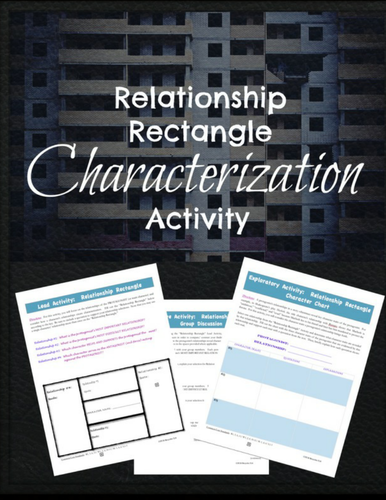
This listing is for a characterization activity entitled "Relationship Rectangle" in which students analyze how a character's relationships work to develop character traits.
This mini-lesson is part of the Mega Characterization Bundle of over 15 characterization mini-lessons that get your students working with all literary devices and techniques. You can find it listed separately in our store.
Bundle and save over $15.00!
For this mini-lesson:
"Relationship Rectangle"
Task
To analyze how character relationships contribute to character development
Objectives
To develop criteria for analyzing character
To assess comprehension of character development across a text
To select appropriate academic vocabulary for literary analysis
To support analysis with textual evidence
To communicate and defend an argument through class discussion
Common Core Standards
R1, 3, 6, 11/ W1, 2, 4, 10-11/ SL 1, 4, 6/ L1-3
Instructions
For this activity, students will consider how the protagonist’s relationships in a story develop characterization. The “Relationship Rectangle” asks students to focus on the protagonist’s key relationships, including the protagonist’s most important relationship, most difficult relationship, the relationship that provides the protagonist with the most help and support, and finally the antagonist that acts against the protagonist throughout the story. Student’s selections for these relationships may vary, but students are asked to support their relationship selections with textual evidence and then discuss their findings with a group. Through this discussion, students will begin to agree/ disagree with each other’s relationship selections as a means of synthesizing how relationships in a story serve to characterize the protagonist.
Students are then asked to develop an analytical paragraph that asks them to analyze how one particular relationship constructs the characterization of the protagonist. I have provided a shaping sheet for this analytical paragraph; however, you may wish to use it only for differentiation, with all of your students, or not at all (depending upon your students’ skill levels and needs).
This mini-lesson is part of the Mega Characterization Bundle of over 15 characterization mini-lessons that get your students working with all literary devices and techniques. You can find it listed separately in our store.
Bundle and save over $15.00!
For this mini-lesson:
"Relationship Rectangle"
Task
To analyze how character relationships contribute to character development
Objectives
To develop criteria for analyzing character
To assess comprehension of character development across a text
To select appropriate academic vocabulary for literary analysis
To support analysis with textual evidence
To communicate and defend an argument through class discussion
Common Core Standards
R1, 3, 6, 11/ W1, 2, 4, 10-11/ SL 1, 4, 6/ L1-3
Instructions
For this activity, students will consider how the protagonist’s relationships in a story develop characterization. The “Relationship Rectangle” asks students to focus on the protagonist’s key relationships, including the protagonist’s most important relationship, most difficult relationship, the relationship that provides the protagonist with the most help and support, and finally the antagonist that acts against the protagonist throughout the story. Student’s selections for these relationships may vary, but students are asked to support their relationship selections with textual evidence and then discuss their findings with a group. Through this discussion, students will begin to agree/ disagree with each other’s relationship selections as a means of synthesizing how relationships in a story serve to characterize the protagonist.
Students are then asked to develop an analytical paragraph that asks them to analyze how one particular relationship constructs the characterization of the protagonist. I have provided a shaping sheet for this analytical paragraph; however, you may wish to use it only for differentiation, with all of your students, or not at all (depending upon your students’ skill levels and needs).
Something went wrong, please try again later.
This resource hasn't been reviewed yet
To ensure quality for our reviews, only customers who have purchased this resource can review it
Report this resourceto let us know if it violates our terms and conditions.
Our customer service team will review your report and will be in touch.
$3.00
